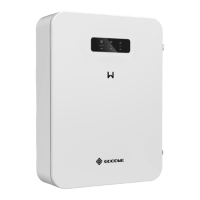13
4 Electrical Connection
4.1 Safety Precaution
NOTICE
• Cable colors in this document are for reference only. The cable specications shall meet local
laws and regulations.
DANGER
INSTRUCTIONS PERTAINING TO A RISK OF FIRE OR ELECTRIC SHOCK
• Perform electrical connections, including operations, cables, and component specications
in compliance with local laws and regulations ANSI/NFPA 70.
• The input and output circuits are isolated from the enclosure and that system grounding,
if required by the National Electric Code, ANSI/NFPA 70, is the responsibility of the installer.
• Power o the device before any electrical connections. Otherwise, an electric shock may
occur.
• Tie the cables of the same type together, and place cables of dierent types apart. Do not
place the cables entangled or crossed.
• If the tension is too large, the cable may be poorly connected. You have to reserve a certain
length of the cable before connecting it to the device cable port.
• Make sure that the cable conductor is in full contact with the terminal and the cable insulation
part is not crimped with the terminal when crimping the terminal. Otherwise, the device may
not be able to work properly, or the connection may be unreliable during working, which
may cause terminal block damage, etc.
4.2 Preparing Conductor Conduit & Fittings
4.2.1 Conduit Holes
WARNING
• Wiring conduits are additionally required, not included in the scope of delivery. The conduit
must be UL514B listed and meet the specications of the waterproof nut.
• To avoid inuencing the protection class or damaging the equipment, check the wiring
conduit to make sure that the conduit is installed properly and the holes are sealed.
AC Grid conduit hole
Inverter conduit hole
AC Loads conduit hole

